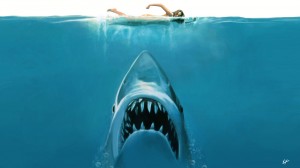Horror flicks terrify using reality
From Saw to The Sixth Sense to Piranha 3D, America has slaked its thirst for horror films. Among cranky zombies and evil little ghost girls, another kind of film still carries legitimate creepy factor. It isn’t about supernatural forces, but something far more terrifying: real life. 
The film Contagion comes out this week, wherein Kate Winslet, Marion Cotillard and Matt Damon battle the forces of plague and pestilence. It is the latest in the genre of thriller-horrors.
The thought of humanity’s impending doom disturbs people more than a cursed videotape. Some of our most pressing fears have changed throughout the decades — such as the threat of the Soviet Union — but others, such as natural disasters, have not. Chucky and Pennywise just don’t stack up against Commies, global warming or virus pandemics.
Though the second Red Scare ended in 1957, the Cold War did not end until 1991. As such, Soviet Communists were the terrorists of the day — provokers of fear, rumors and mob mentality. What’s scarier than a commie who might be living next door? A commie who might be running your government. The Manchurian Candidate (1962) uses this fear to create a harpstring-taut tension as a brainwashed American war hero has become an assassin for the Communists. His puppeteer is his Commie mom Angela Lansbury, who has her sights on her husband’s potential presidency.
Since ancient man first realized it’s not a good idea to hang out in a field during a lightning storm, the elements have earned our respect. And when they destroy our cities and decimate our populace, they earn our hysterical terror. The Poseidon Adventure in 1972 is one of the most successful of the era’s disaster flicks. It harkens back to the dread of a sinking ship but with a twist — a tidal wave has flipped over the sinking ship with the passengers still inside. From then on, it’s a pulse-pounding race to the engine room.
Children of the ’90s might remember the horror of the opening scene of Twister, when the father is sucked up from a cellar during a savage tornado. In 1975, people fled the beaches after the release of Jaws, which terrified viewers with a selachian sea demon from some watery hell, complete with his own theme music.
More recently, Hollywood has tackled the planet’s rebellion against our Hummers and soda cans. The grandest and cheesiest example is Roland Emmerich’s entertaining The Day After Tomorrow, where global warming causes a new ice age.
Fear of things we can do is a recent addition to the American film psyche. In addition to destroying the planet, humanity’s proclivity for the frontiers of science has also come under fire. Though technically a sci-fi film, Vincenzo Natali’s 2009 Splice gives viewers a taste of what cloning can cause. That taste is a ferocious hybrid creature that slaughters kitties and seduces its masters. Dolly doesn’t look so cute anymore.
Even scarier than when science goes wrong is when it fails. America has the most advanced medical centers in the world — but what happens if a plague breaks out and we can do nothing to stop it? Most plague films today involve mutant children or zombies, but an unstoppable disease is unsettling in its own right. Contagion hones in on this uneasy potential. It has no zombie outbreaks or alien invasions, just old fashion death and decimation. This fear is very much present in American culture — just how nuts did people go when swine flu broke out?
As time goes on, there appears to be a shift in what scares us. Yesteryear, many real life fear films involved hostile external forces. Today, many of our fears stem from horrors we can unwittingly cause, like global warming. At the same time, we live in an age where we have access to massive quantities of information. PubMed — the free database — alone is enough to turn fatigue and stress into a Lupus self-diagnosis.
As the saying goes, the more you know, the more you have to worry about. Perhaps producers should look more to newspapers than Asian cinema for the next horror hit.
Mimi Honeycutt is a senior majoring in print and digital journalism. Her column “Cut to Frame” runs Fridays.
